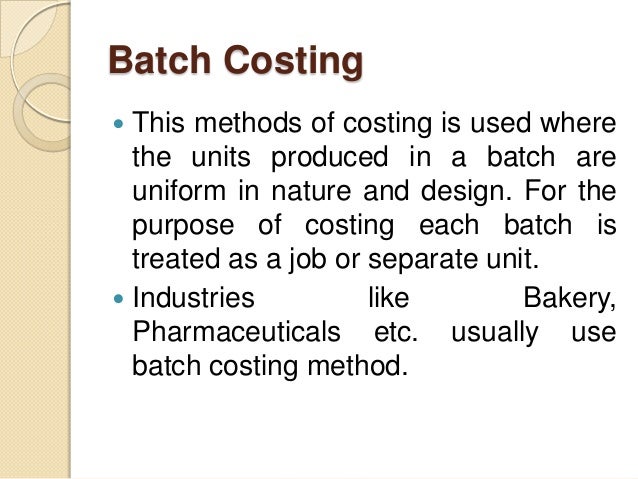
However, since standard costs are inexact, this costing method is not practical for many manufacturing situations and should be used with caution. To choose the right inventory costing method for your business, you must first understand your costs and how they change over a year. The LIFO costing method can produce lower recorded profits at the end of a financial year, which in turn might reduce taxes, making it attractive to some business owners.
Ask Any Financial Question
This method is followed by departmental stores, publishing houses etc. This method is applicable where services are rendered rather than goods produced. The total expenses of the operation are divided by the units and cost per unit of service is arrived at. This is followed in transport undertakings, municipalities, hospitals, hotels etc. A cost sheet is created while accounting for labor, material, and overhead costs. Mining, oil drilling, cement and brick making, unit production cycles, radios, washing machines, and other industries can all use unit costing.
Assisting Management
Under job costing, each job or order is given a number and all costs are booked in a form called “Job order cost sheet”. The procedure of costing is broadly the same as for process costing except that cost unit is an operation instead of a process. For example, the manufacturing of handles for bicycles involves a number of operations such as those of cutting steel sheets into proper strips, moulding, machining and finally polishing. The cost of each one of these operations may be found out separately. It is the use of same costing principles and/or practices by several undertakings for common control or comparison of costs. When used and operated under a centralized control system, uniform costing will promote operating efficiency by ensuring inter-firm comparisons.

Explanation of Activity-Based Costing
It is then applied to every outbound inventory transaction until the next time the item is bought and received into inventory. It could not be worth the expense, for instance, if one technique of figuring out your costs is 7% more accurate than the other. You may provide the best value for both yourself and your customers while relieving your accountant’s burden by using the costing method that is most appropriate for your firm. Cost accounting assists a company’s management team in carrying out its day-to-day functions of control and formulating business policies. Cost accounting is concerned with the collection, processing, and evaluation of operating data in order to achieve goals relating to internal planning, control, and external reporting. Significantly, costing also provides an independent but reliable check on financial accounting.
- This method is followed where the final product consists of a number of separate parts, e.g., radio set, motor car, bicycle etc.
- The total expenses of the operation are divided by the units and cost per unit of service is arrived at.
- This will allow you to see how well it works in practice and ensure it will fit your needs.
- When a product passes through different stages, each of which is distinct, well-defined, and easily separable, process costing can be applied.
Because, a sound Cost Accounting system must aim at not only ascertaining costs but also control of costs. The methods to be used for cost ascertainment depend on nature of industry. Costs of production or service rendered differ from industry to industry. For instance, the manufacture of handles for bicycles involves a number of operations such as cutting steel sheets into proper strips, moulding, machining and finally polishing. Operation costing provides a minute analysis of costs to achieve accuracy and it is applied in industries such as spare parts, toy making and engineering.
Kaizen Costing- Common Costing Methods
Consider any regulatory implications that may apply to your business, including environmental, labor, and tax laws. For example, if you’re a manufacturing company and want to expand your operations into China, it’s important to consider China’s environmental regulations before moving. Understanding the benefits of each method is an integral part of the decision-making process because it will help you decide which method is suitable for your company. Some plans have more benefits than others, and some have fewer drawbacks.
When discussing production costs, it’s easy to focus solely on direct costs like raw materials and labor. Businesses, especially those starting out, often forget lifo liquidation how does it work effects of lifo liquidation to consider these hidden expenses when determining product prices. Manufacturers will prioritize direct costs, or expenses directly related to manufacturing.
Since this method provides for a minute analysis of costs, it ensures greater accuracy and better control of costs. This method of costing is followed by concerns producing a single article or a few articles which are identical and capable of being expressed in simple, quantitative units. This is used in industries like mines, quarries, oil drilling, cement works, breweries, brick works etc. for example, a tonne of coal in collieries , one thousand bricks in brick works etc. In addition to the methods of costing, there are certain techniques of costing, which are used along with any of the method. MRP software gives you on-demand insights into different production costs at the click of a button.
Manufacturers have used ABC extensively for decades because it helps them determine how much each part of an assembly line contributes to the overall cost of making a product. Inventory costing is assigning an item’s cost to the period it’s used, sold, or removed from inventory. Process costing is most commonly used by manufacturers, such as automobile manufacturers, with high product variability. It can also be used by companies that manufacture products with various sizes or qualities. You may have a situation where you must purchase raw materials from different vendors and sell the same or similar products to other customers at different prices.